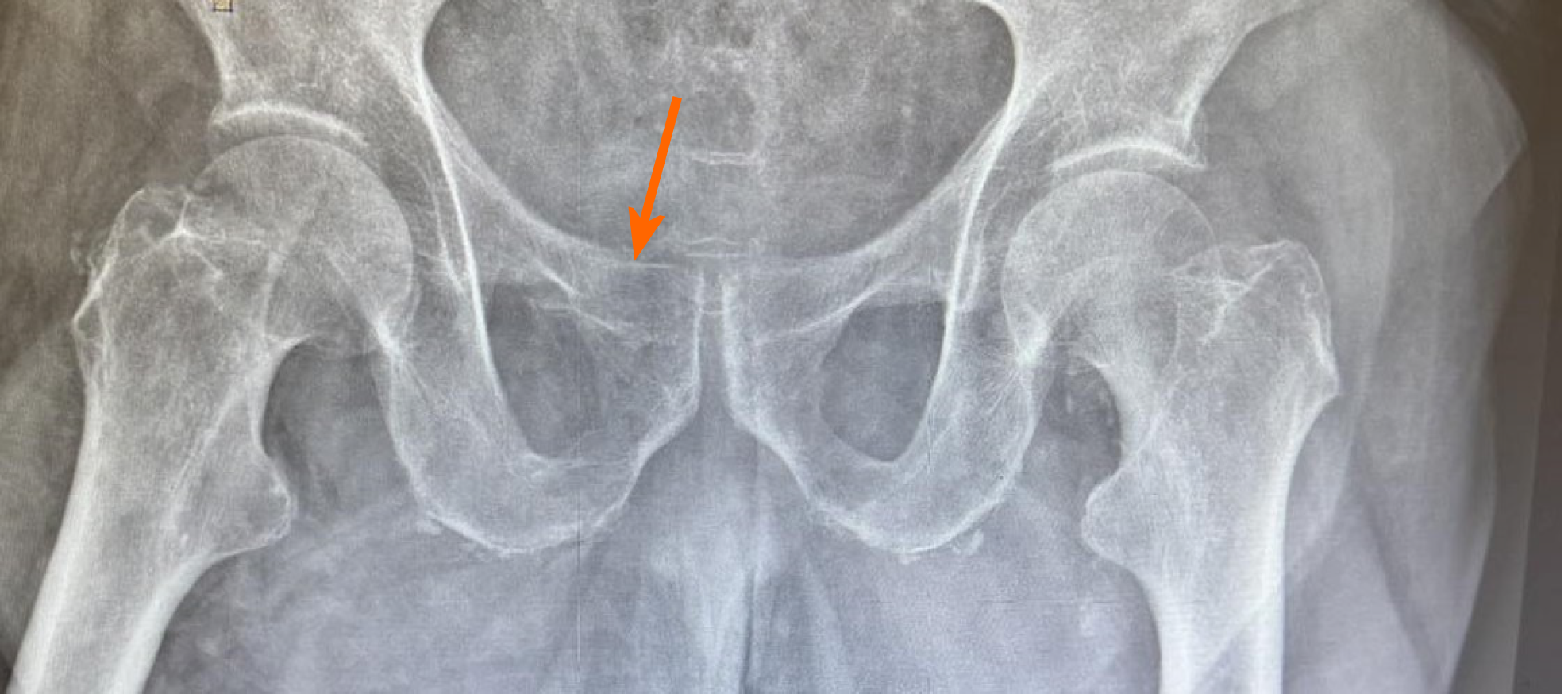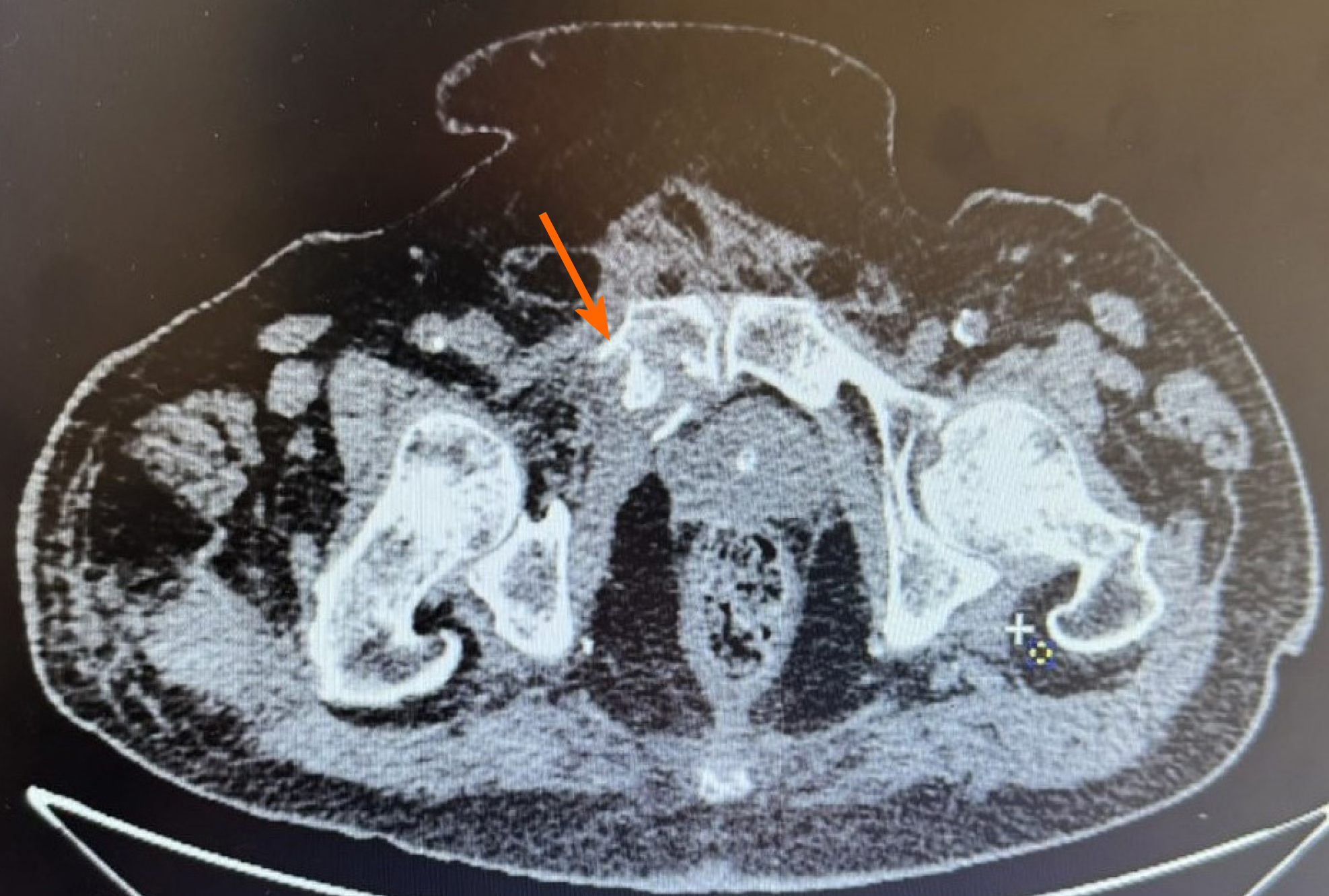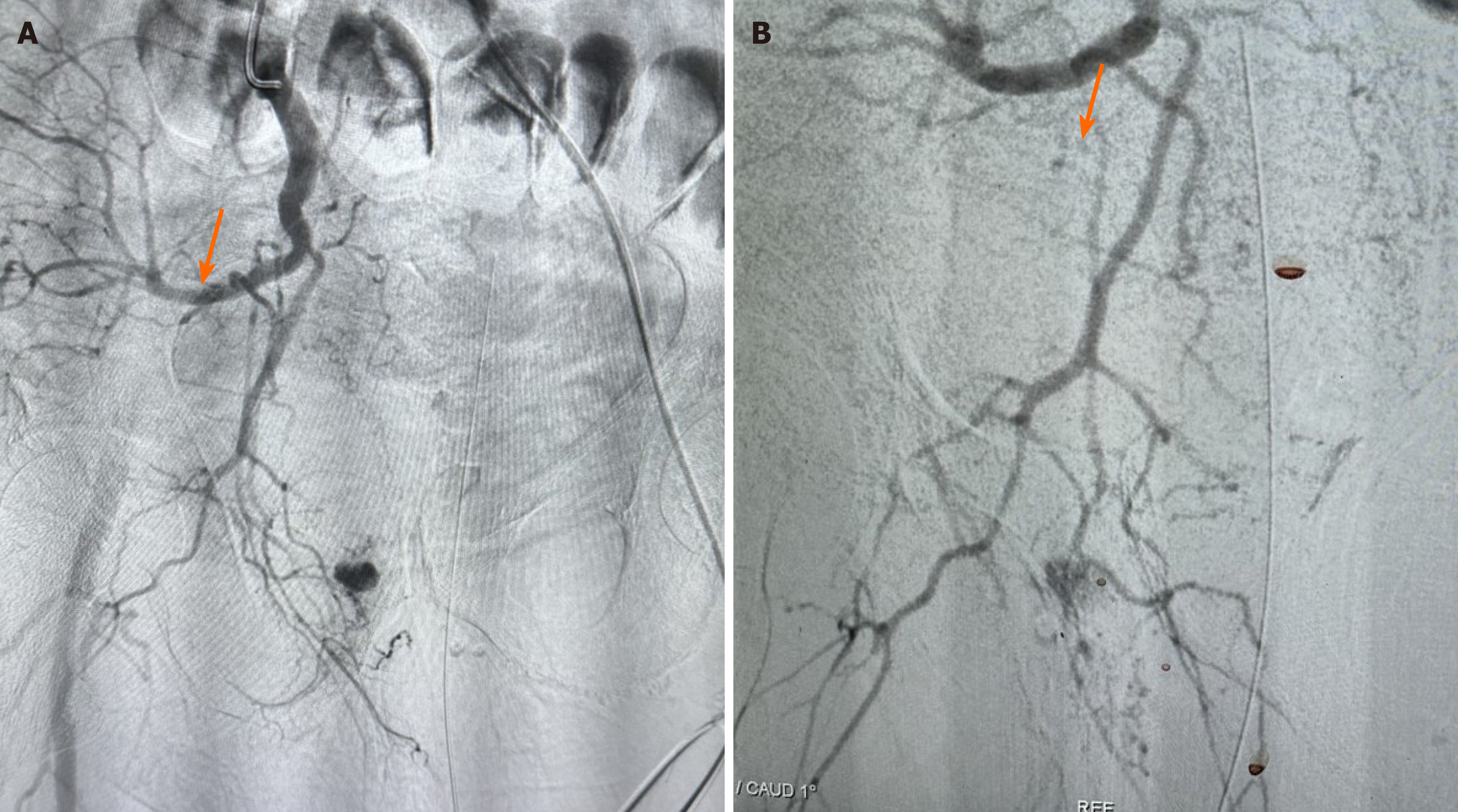Published online Jul 26, 2025. doi: 10.12998/wjcc.v13.i21.103786
Revised: February 20, 2025
Accepted: March 24, 2025
Published online: July 26, 2025
Processing time: 148 Days and 16.3 Hours
Pubic ramus fractures are generally considered fragility fractures in the elderly population, commonly deriving from a low-impact fall. Treatment is ordinarily conservative and hemodynamic complications are exceedingly infrequent. Notwithstanding, patients with copious comorbidities should be carefully monitored for potential vascular injury.
This case report presents the management of a 75-year-old male patient with a history of diabetes mellitus and arterial hypertension who was admitted to the emergency room with a superior pubic ramus fracture. The patient experienced a significant drop in hematocrit and hemoglobin levels post-admission, necessi
This report denotes the various challenges and strategies in managing simple fractures that are treated conservatively, but need prompt monitoring for occult vascular injuries that can be fatal.
Core Tip: Elderly patients with copious comorbidities, like diabetes mellitus and arterial hypertension, can potentially pose unique challenges in trauma management. Fragility fractures of the anterior pelvic ring are regarded as minor injuries, featuring rare complications. Hemodynamic monitoring is essential in management of these injuries. Fracture-associated occult vascular injuries are tremendously rare and can be fatal. The felicitous management of this case underlines the significance of multidisciplinary approach in the treatment of aged individuals with intricate past medical history. Continuous monitoring, timely diagnostic interventions, and pertinent therapeutic strategies are requisite in ensuring positive outcomes.
- Citation: Sakellariou E, Argyropoulou E, Galanis A, Rozis M, Zachariou D, Varsamos I, Parchas N, Kalavrytinos D, Karampinas P, Vasiliadis ES, Vlamis J, Pneumaticos S. Life-threatening vascular injury in an elderly patient with isolated pubic ramus fracture: A case report. World J Clin Cases 2025; 13(21): 103786
- URL: https://www.wjgnet.com/2307-8960/full/v13/i21/103786.htm
- DOI: https://dx.doi.org/10.12998/wjcc.v13.i21.103786
Elderly patients with multiple comorbidities, such as diabetes mellitus and arterial hypertension, present unique challenges in trauma management. Pubic ramus fractures are fragility fractures of the pelvis (FFP) common seen in the elderly population following a fall. They are fractures of the anterior pelvic ring, more specifically are classified as FFP I, by Rommens and Hofmann[1] and can be treated conservatively with pain medication and early mobilization[2]. These fractures are considered minor injuries, as they are stable and have rare complications. Furthermore the risk of hemodynamic instability is estimated at 2%-3%[3].
The following case report details the presentation, diagnosis, and management of a 75-year-old patient with a superior pubic ramus fracture, highlighting the complications and the multidisciplinary approach required for successful treatment and the necessity of close monitoring these patients.
Severe persistent right hip region pain, painful right hip range of motion and complete inability to weight-bear.
A 75-year-old male patient presented to the emergency department of our hospital, with severe pain and immobility in the right hip region following a low-impact fall from his own height. He was hemodynamically stable, oriented and had no other injuries.
No relevant past illnesses were reported. The patient did not experience any previous falls.
The patient featured a medical history significant for insulin dependent diabetes mellitus, arterial hypertension and atrial fibrillation, that was treated with apixaban. Family’s past medical history was negligible.
Right hip region pain was isolated and the patient did not complain about pain in other areas of his body. Right hip range of motion was limited owing to persistent groin pain during examination. No evident leg-length discrepancy was descried. No weakness, numbness or tingling were observed regarding the affected lower limb. No skin lacerations were found. No groin subcutaneous hematoma was observed. Log roll test and Thomas test were negative. Vital signs were: Temperature of 36.5 ˚C, pulse rate was 81 beats per minute, respiration rate was 14 breaths per minute, and blood pressure was 135/85 mmHg. Also, lungs auscultation was normal and no fremitus was noted.
Typical blood tests were conducted immediately upon admission to the emergency room, and hemoglobin (Hb) concentration was measured 14.1 g/dL, whilst blood urea nitrogen (BUN) and creatine levels were within normal range. Moreover, platelet count and white blood count were also normal.
A plain pelvis X-ray was carried out, demonstrating an isolated right superior pubic ramus fracture (Figure 1). Forthwith after the initial diagnosis of the injury, a pelvis computed tomography (CT) scan was conducted for more rigorous evaluation of the fracture (Figure 2). No considerable hematoma was observed at this CT scan.
Isolated right superior pubic ramus fracture.
Initial management included immobilization of the affected limb, apposite pain management with intravenous analgesics, and utter discontinuation of apixaban treatment. Contrariwise, low molecular weight heparin (LMWH) treatment was initiated after the halt of the apixaban as a replacement. LMWH selected was enoxaparin sodium 4000 IU/ 0.4 mL twice per day as full anticoagulation taking into account the patient’s medical history. Furthermore, initial management involved thorough monitoring of vital signs along with routine blood workup.
On the third post-admission day, patient’s hematocrit (Ht) levels dropped by 10% (from 42% on admission day to 32%), while a renal impairment was observed with BUN at 150 g/dL and creatinine 2.2 mg/dL. Our medical team carried on close hemodynamic monitoring and supportive care. At this stage, LMWH treatment was reduced to once per day. Despite the decrease in Ht, no immediate intervention was deemed necessary at this stage as the patient was clinically stable. Nonetheless, on the fourth post-admission day, the patient’s Ht dropped an additional 5 units in comparison with the previous day, and his Hb levels dropped correspondingly (Ht/Hb: 27%/9 g/dL). Consequently, this noteworthy drop prompted an urgent diagnostic intervention, and a CT angiography was executed, whilst also the patient was blood transfused. LMWH treatment was completely terminated. In terms of physical examination, no visible hematoma was observed in the thigh or inguinal region, however, on the fourth post-admission day diffuse tender swelling in the right iliac fossa was noted.
The digital subtraction angiography revealed active bleeding from a branch of the medial femoral artery (Figure 3A). The lost blood was accumulated chiefly around the area of piriformis, gemellus superior, gemellus inferior and obturatorius externus muscles. Emergency embolization of the bleeding artery was performed to stabilize the patient (Figure 3B). Liquid glue was utilized as embolic agent. Following the embolization, the patient’s vital signs stabilized and the BUN and creatinine concentrates normalized. LMWH treatment was reinstated four days after the embolization. Intensive monitoring continued in the hospital for a total of 15 days for continuous monitoring, mobilization by physiotherapists and antibiotic medication for a respiratory infection he developed.
The patient was discharged in a hemodynamically stable condition after 15 days of hospitalization. Arrangements were made for home-based continuous hospitalizations to monitor and regulate his blood sugar levels, considering his diabetic status. Long-term management included adjustments in medication and diet to maintain blood glucose levels within the target range. Additionally, the patient was prescribed physical therapy to aid in the recovery of the affected limb.
Pubic ramus fractures in elderly are considered insufficiency fractures and if they are classified by the FFP[1]. Pelvic ring fractures in those patients, used to be a minority in comparison with all the other fractures, but due to the vast increase of life expectancy, anterior pelvic fractures have also increased at 7%[4,5].
The complication following this type of fracture are rare but severe and majority of them are caused by hospitalization and immobility, like urinary tract infection, pneumonia, depression, thromboembolic events and loss of independence[6]. Even more scarce, are perforation of the urinary bladder or injury to the genital organs from displaced bony fragments, but this displacement is more commonly found after high energy trauma[3]. A non-displaced superior pubic ramus fracture is categorized as minor injury and in elderly population with this fracture, the risk of hemodynamic instability is 2%, but patients with atherosclerotic vessels from diabetes mellitus or hypertension have more fragile vessels and the risk is increases, especially if they are on antithrombotic medication[7,8].
This case underscores the complexity of managing elderly trauma patients with comorbid conditions. After reviewing the literature, there is only one other case report by Macdonald et al[9], with massive hemorrhage in a 71 years old patient after an isolated pubic ramus fracture following a low-energy trauma. The significant drop in Ht and Hb highlighted the need for vigilant monitoring and timely intervention. The use of CT angiography followed by targeted embolization was crucial in stabilizing the patient.
The literature emphasizes the importance of meticulous blood glucose control in diabetic patients to prevent complications and promote healing[10]. Embolization has been shown to be an effective and minimally invasive method to control hemorrhage in trauma patients, reducing the need for more extensive surgical interventions[11]. Early identification of hemodynamic instability and appropriate use of imaging modalities are critical in the management of trauma patients with potential internal bleeding[12]. Diabetic patients often face delayed bone healing, requiring close monitoring and potential interventions to support the fracture repair process[13]. CT angiography is a valuable diagnostic tool for identifying vascular injuries in trauma patients, guiding therapeutic decisions and interventions[14]. Studies have demonstrated the safety and efficacy of embolization procedures in elderly patients, highlighting the importance of tailored interventions in this population[15].
Additional studies have provided insights into the specific challenges and approaches in managing fractures and bleeding in elderly patients. For example, Reprint et al[16] discussed the challenges of managing fractures in elderly patients with diabetes, emphasizing the need for specialized care protocols. Similarly, a study by Uyeda et al[14] highlighted the role of advanced imaging techniques, including CT angiography, in improving the diagnosis and management of vascular injuries in trauma patients. Furthermore, research by Avila et al[17] explored the long-term outcomes of embolization procedures in elderly trauma patients, providing valuable data on the efficacy and safety of this intervention.
Determining the direct root of internal pelvic hemorrhage following trauma can be arduous owing to the complex vast anastomotic vascular network within the pelvis. In cases of bleeding from pubic branches, it is advisable to recognize the inferior epigastric artery, obturator artery or anatomical variations as potential causes of bleeding[18]. Solarz et al[19] have described an interesting case where a superior pubic ramus fracture from a low-energy fall resulted in massive bleeding from injury of the obturator artery which required angiographic intervention. In addition, Lu et al[20] in 2010 reported two cases of isolated pubic ramus fracture complicated by injury of the pubic branch of the inferior epigastric artery that triggered hemodynamic instability. On the other hand, internal pudendal artery injury can be a potentially devastating complication of pelvic fractures causing severe bleeding, especially in “open-book” type of fractures[21].
An anterior pelvic fracture in elderly, needs prompted analgetic therapy and early mobilization to minimize the complications. Also, we recommend hemodynamic monitoring for at least 24 hours, in such cases and especially if the patients are under antithrombotic medication, in order to identify early concurrent hemorrhage with CT angiography and then rapidly treated with embolization.
The successful management of this case highlights the importance of a multidisciplinary approach in the care of elderly patients with complex medical histories. Continuous monitoring, timely diagnostic interventions, and appropriate therapeutic strategies are paramount in ensuring positive outcomes.
| 1. | Rommens PM, Hofmann A. Comprehensive classification of fragility fractures of the pelvic ring: Recommendations for surgical treatment. Injury. 2013;44:1733-1744. [RCA] [PubMed] [DOI] [Full Text] [Cited by in Crossref: 281] [Cited by in RCA: 331] [Article Influence: 27.6] [Reference Citation Analysis (0)] |
| 2. | Oberkircher L, Ruchholtz S, Rommens PM, Hofmann A, Bücking B, Krüger A. Osteoporotic Pelvic Fractures. Dtsch Arztebl Int. 2018;115:70-80. [RCA] [PubMed] [DOI] [Full Text] [Cited by in Crossref: 34] [Cited by in RCA: 57] [Article Influence: 8.1] [Reference Citation Analysis (0)] |
| 3. | Küper MA, Trulson A, Stuby FM, Stöckle U. Pelvic ring fractures in the elderly. EFORT Open Rev. 2019;4:313-320. [RCA] [PubMed] [DOI] [Full Text] [Full Text (PDF)] [Cited by in Crossref: 12] [Cited by in RCA: 35] [Article Influence: 5.8] [Reference Citation Analysis (0)] |
| 4. | Burge R, Dawson-Hughes B, Solomon DH, Wong JB, King A, Tosteson A. Incidence and economic burden of osteoporosis-related fractures in the United States, 2005-2025. J Bone Miner Res. 2007;22:465-475. [RCA] [PubMed] [DOI] [Full Text] [Cited by in Crossref: 2687] [Cited by in RCA: 2932] [Article Influence: 162.9] [Reference Citation Analysis (0)] |
| 5. | Soles GL, Ferguson TA. Fragility fractures of the pelvis. Curr Rev Musculoskelet Med. 2012;5:222-228. [RCA] [PubMed] [DOI] [Full Text] [Cited by in Crossref: 55] [Cited by in RCA: 70] [Article Influence: 5.4] [Reference Citation Analysis (0)] |
| 6. | Maier GS, Kolbow K, Lazovic D, Horas K, Roth KE, Seeger JB, Maus U. Risk factors for pelvic insufficiency fractures and outcome after conservative therapy. Arch Gerontol Geriatr. 2016;67:80-85. [RCA] [PubMed] [DOI] [Full Text] [Cited by in Crossref: 51] [Cited by in RCA: 77] [Article Influence: 8.6] [Reference Citation Analysis (0)] |
| 7. | Krappinger D, Zegg M, Jeske C, El Attal R, Blauth M, Rieger M. Hemorrhage after low-energy pelvic trauma. J Trauma Acute Care Surg. 2012;72:437-442. [RCA] [PubMed] [DOI] [Full Text] [Cited by in Crossref: 7] [Cited by in RCA: 14] [Article Influence: 1.1] [Reference Citation Analysis (0)] |
| 8. | Sandri A, Regis D, Bizzotto N. Delayed bleeding and pelvic haematoma after low-energy osteoporotic pubic rami fracture in a warfarin patient: an unusual cause of abdominal pain. Case Rep Emerg Med. 2014;2014:783268. [RCA] [PubMed] [DOI] [Full Text] [Full Text (PDF)] [Cited by in Crossref: 1] [Cited by in RCA: 8] [Article Influence: 0.7] [Reference Citation Analysis (0)] |
| 9. | Macdonald DJ, Tollan CJ, Robertson I, Rana B. Massive haemorrhage after a low-energy pubic ramus fracture in a 71-year-old woman. Postgrad Med J. 2006;82:e25. [RCA] [PubMed] [DOI] [Full Text] [Cited by in Crossref: 23] [Cited by in RCA: 25] [Article Influence: 1.3] [Reference Citation Analysis (0)] |
| 10. | Su H, Liu H, Liu J, Wang X. Elderly patients with intertrochanteric fractures after intramedullary fixation : Analysis of risk factors for calf muscular vein thrombosis. Orthopade. 2018;47:341-346. [RCA] [PubMed] [DOI] [Full Text] [Cited by in Crossref: 15] [Cited by in RCA: 18] [Article Influence: 2.6] [Reference Citation Analysis (0)] |
| 11. | Lopera JE. Embolization in Trauma: Review of Basic Principles and Techniques. Semin Intervent Radiol. 2021;38:18-33. [RCA] [PubMed] [DOI] [Full Text] [Cited by in Crossref: 4] [Cited by in RCA: 18] [Article Influence: 4.5] [Reference Citation Analysis (0)] |
| 12. | Nolan JP, Sandroni C, Böttiger BW, Cariou A, Cronberg T, Friberg H, Genbrugge C, Haywood K, Lilja G, Moulaert VRM, Nikolaou N, Olasveengen TM, Skrifvars MB, Taccone F, Soar J. European Resuscitation Council and European Society of Intensive Care Medicine guidelines 2021: post-resuscitation care. Intensive Care Med. 2021;47:369-421. [RCA] [PubMed] [DOI] [Full Text] [Full Text (PDF)] [Cited by in Crossref: 536] [Cited by in RCA: 604] [Article Influence: 151.0] [Reference Citation Analysis (0)] |
| 13. | Jiao H, Xiao E, Graves DT. Diabetes and Its Effect on Bone and Fracture Healing. Curr Osteoporos Rep. 2015;13:327-335. [RCA] [PubMed] [DOI] [Full Text] [Cited by in Crossref: 263] [Cited by in RCA: 354] [Article Influence: 35.4] [Reference Citation Analysis (0)] |
| 14. | Uyeda JW, Anderson SW, Sakai O, Soto JA. CT angiography in trauma. Radiol Clin North Am. 2010;48:423-438, ix. [RCA] [PubMed] [DOI] [Full Text] [Cited by in Crossref: 62] [Cited by in RCA: 55] [Article Influence: 3.7] [Reference Citation Analysis (0)] |
| 15. | Klausenitz C, Kuehn JP, Noeckler K, Radosa CG, Hoffmann RT, Teichgraeber U, Mensel B. Efficacy of transarterial embolisation in patients with life-threatening spontaneous retroperitoneal haematoma. Clin Radiol. 2021;76:157.e11-157.e18. [RCA] [PubMed] [DOI] [Full Text] [Cited by in Crossref: 5] [Cited by in RCA: 18] [Article Influence: 3.6] [Reference Citation Analysis (0)] |
| 16. | Reprint SI, Testa G. Orthopedic Treatment of Diseases and Fractures in Elderly. Orthopedic Treatment of Diseases and Fractures in Elderly. 2023. Available from: https://www.mdpi.com/journal/jcm/special_issues/Orthopedic_Treatment_Diseases_Fractures_Elderly. |
| 17. | Avila M, Bhogadi SK, Nelson A, Hosseinpour H, Ditillo M, Akl M, Anand T, Spencer AL, Magnotti LJ, Joseph B. The long-term risks of venous thromboembolism among non-operatively managed spinal fracture patients: A nationwide analysis. Am J Surg. 2023;225:1086-1090. [RCA] [PubMed] [DOI] [Full Text] [Cited by in RCA: 10] [Reference Citation Analysis (0)] |
| 18. | Almaguer J, Murray D, Murray M, Murray R. Differentiating Between Obturator and Inferior Epigastric Arterial Injury in Traumatic Pelvic Hemorrhage: A Case Report. Cureus. 2023;15:e44593. [RCA] [PubMed] [DOI] [Full Text] [Reference Citation Analysis (0)] |
| 19. | Solarz MK, Kistler JM, Rehman S. Obturator Artery Injury Resulting in Massive Hemorrhage From a Low-Energy Pubic Ramus Fracture. Orthopedics. 2017;40:e546-e548. [RCA] [PubMed] [DOI] [Full Text] [Cited by in Crossref: 2] [Cited by in RCA: 2] [Article Influence: 0.3] [Reference Citation Analysis (0)] |
| 20. | Lu C, Lee Y, Sun P, Liang C, Liliang P. Life-Threatening Bleeding from the Pubic Branch of the Inferior Epigastric Artery after Pubic Ramus Fracture. Hong Kong J Emerg Med. 2010;17:372-376. [RCA] [DOI] [Full Text] [Cited by in Crossref: 3] [Cited by in RCA: 3] [Article Influence: 0.4] [Reference Citation Analysis (0)] |
| 21. | Elhence A, Gahlot N, Gupta A, Garg P. Internal Pudendal Artery Injury Following An Open Book Pelvic Fracture: A Case Report. Malays Orthop J. 2020;14:180-183. [RCA] [PubMed] [DOI] [Full Text] [Full Text (PDF)] [Reference Citation Analysis (0)] |











